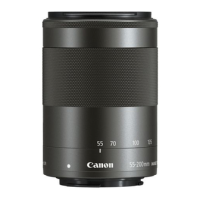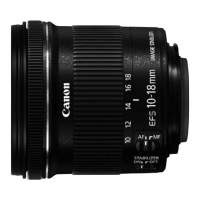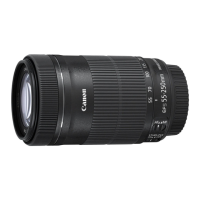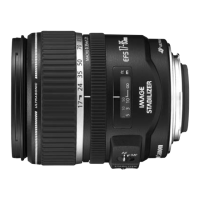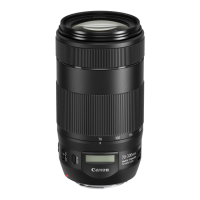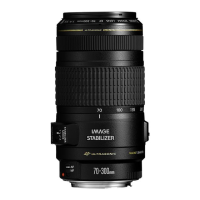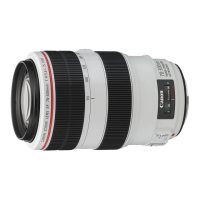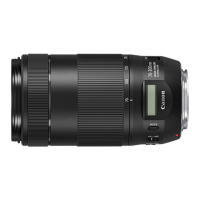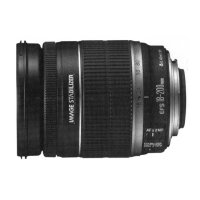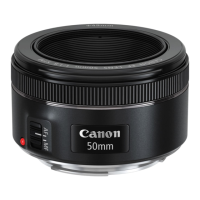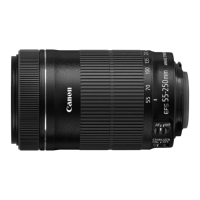
Do you have a question about the Canon EF-S55-250mm f/4-5.6 IS STM and is the answer not in the manual?
| Mount | Canon EF-S |
|---|---|
| Focal Length | 55-250mm |
| Maximum Aperture | f/4-5.6 |
| Minimum Aperture | f/22-32 |
| Lens Construction | 15 elements in 12 groups |
| Minimum Focus Distance | 0.85m |
| Filter Size | 58mm |
| Weight | 375g |
| Maximum Magnification | 0.29x |
| Number of Diaphragm Blades | 7 |
| Image Stabilization | Yes (3.5 stops) |
| Autofocus | Yes |
Enhances movie shooting with quiet, smooth servo AF using a stepping motor.
Achieves fast and silent autofocus during viewfinder shooting.
Utilizes UD lens elements for superior imaging performance.
Provides 3.5 stops faster stabilization, adapting to shooting conditions.
Enables manual focus adjustments via the focusing ring's electronic detection.
Allows manual focus adjustments after initial autofocus in ONE SHOT AF.
Features a circular aperture for attractive bokeh and soft-focus images.
Guidance on preventing condensation and avoiding high temperatures.
Recommendations for firmware updates for specific camera models.
Warnings about direct sun viewing and fire hazards from concentrated sunlight.
Explanation of symbols used for warnings and supplementary notes.
Details compliance with FCC rules for digital apparatus, preventing harmful interference.
States compliance with Canadian ICES-003 for digital apparatus.
Provides steps to correct radio or television reception interference.
Explains limitations like no manual focus and delayed zoom when the camera is off.
Describes sleep mode, motor inactivity, delayed focus, and exiting sleep mode.
Details the focus lens reset on camera power-up and advises waiting before shooting.
Identifies key parts of the lens, such as rings, switches, and indexes.
Guidance on handling the lens after detachment and attaching the dust cap.
Instructions for setting the focus mode switch to AF for autofocus.
Instructions for setting the focus mode switch to MF for manual focus.
Describes manual focusing after AF by pressing the shutter halfway.
Warns that fast rotation of the focusing ring may cause delayed focus.
States that manual focus is not possible when the camera is OFF.
Explains that zooming is controlled by turning the lens' zoom ring.
Advises finishing zooming before focusing for accuracy.
Notes that rapid zoom ring rotation may cause temporary blurring.
Describes the hood's purpose and how to attach it securely.
Warns that incorrect hood attachment can lead to vignetting.
Advises grasping the base of the hood to prevent deformation during attachment.
Explains the stabilizer works in AF or MF mode and adapts to shooting conditions.
Clarifies it cannot compensate for subject movement or extreme shaking.
Notes that the Image Stabilizer consumes more power, reducing shot count.
Describes compensation for camera shake in all directions for static subjects.
Explains compensation for vertical shake during horizontal panning and vice versa.
Recommends turning off the stabilizer when using a tripod to save battery.
States effectiveness with monopod is similar to hand-held, but environment may affect it.
Confirms the stabilizer works with Extension Tubes EF12 II or EF25 II.
Mentions changing camera custom functions to operate the stabilizer with assigned buttons.
Effective in semi-darkened areas like indoors or outdoors at night.
Effective in locations where flash photography is prohibited, like museums.
Effective in situations where footing is uncertain.
Effective when fast shutter settings cannot be used.
Effective when panning subjects in motion.
Filters can be attached to the filter mounting thread on the front of the lens.
Only one filter can be attached at a time.
Recommends Canon Circular Polarizing Filter PL-C B (58 mm) for polarizing needs.
Advises removing the lens hood before adjusting a polarizing filter.
Extension tubes EF12 II or EF25 II can be attached for magnified shots.
Provides shooting distances and magnifications with extension tubes.
Recommends using MF mode for accurate focusing with extension tubes.
Attaching 250D or 500D close-up lenses enables close-up photography.
Lists magnification ranges for Close-up Lens 250D (0.23x-1.04x) and 500D (0.11x-0.66x).
Recommends MF mode for accurate focusing with close-up lenses.
Details focal length, aperture, construction, focusing distance, magnification, and field of view.
Lists filter diameter, maximum dimensions, length, and the lens's weight.
Covers hood, lens cap, case, and extender compatibility.
Explains measurement methods, format equivalence, and notes on data standards.
